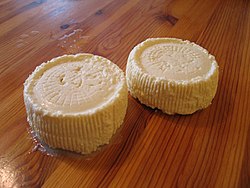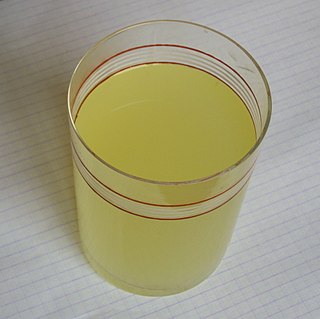
Whey is the liquid remaining after milk has been curdled and strained. It is a byproduct of the manufacturing of cheese or casein and has several commercial uses. Sweet whey is a byproduct resulting from the manufacture of rennet types of hard cheese, like cheddar or Swiss cheese. Acid whey is a byproduct brought out during the making of acid types of dairy products, such as strained yogurt.

Mizithra or myzithra is a Greek whey cheese or mixed milk-whey cheese from sheep or goats, or both. It is sold both as a fresh cheese, similar to Italian ricotta, and as a salt-dried grating cheese, similar to Italian ricotta salata. The ratio of milk to whey is usually 7 to 3.

Goat cheese, goat's cheese or chèvre is cheese made from goat's milk. Goats were among the first animals to be domesticated for producing food. Goat cheese is made around the world with a variety of recipes, giving many different styles of cheeses, from fresh and soft to aged and hard.

Ricotta is an Italian whey cheese made from sheep, cow, goat, or Italian water buffalo milk whey left over from the production of other cheeses. Like other whey cheeses, it is made by coagulating the proteins that remain after the casein has been used to make cheese, notably albumin and globulin.

Acid-set or sour milk cheese is cheese that has been curdled (coagulated) by natural souring, often from lactic acid bacteria, or by the addition of acid. This type of cheese is technologically simple to produce.
Xynomizithra or xynomyzithra is a Greek whey cheese with some added milk; it is a sour variant of Mizithra, and made from ewes' and/or goats' milk. The proportion of full-cream milk is about 15%.
White cheese includes a wide variety of cheese types discovered in different regions, sharing the sole common characteristic of their white hue. The specific type of white cheese can vary significantly depending on the geographical location.

Requeijão is a milk-derived product, produced in Portugal and Brazil. It is a loose, ricotta-like cheese used to make cheese spreads. It can be a good substitute to mild, unsalty ricotta. This variety is sometimes sold in the markets wrapped in fresh corn husks. In El Salvador, cheeses such as requesón can sometimes be transported wrapped in banana leaves instead.

Caprino is an Italian cheese traditionally made from whole or skimmed goat's milk. The name of the cheese derives from the Italian word for goat, capra. With modern methods of production, the cheese is made from cow's milk as well or a combination of both cow's and goat's milks. The two major styles of caprino are fresco ("fresh") and stagionato ("aged").

There are many different types of cheese. Cheeses can be grouped or classified according to criteria such as length of fermentation, texture, methods of production, fat content, animal milk, and country or region of origin. The method most commonly and traditionally used is based on moisture content, which is then further narrowed down by fat content and curing or ripening methods. The criteria may either be used singly or in combination, with no single method being universally used.
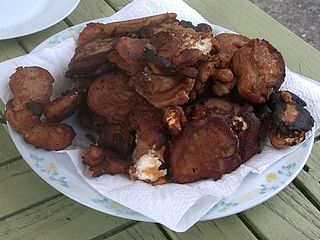
Fritelli, also Fritelle are Corsican doughnuts or fritters made from fried wheat or chestnut flour. A preparation of the fritters is referred to as Fritelli di Casgiu Frescu with fresh cheese or Fritelli di Salciccia with sausage.
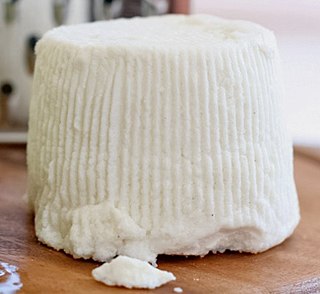
Whey cheese is a dairy product made of whey, the by-product of cheesemaking. After the production of most cheeses, about 50% of milk solids remain in the whey, including most of the lactose and lactalbumin. The production of whey cheese allows cheesemakers to use the remaining whey, instead of discarding it as a waste product.

Sheep milk cheese is a cheese prepared from sheep milk. Well-known cheeses made from sheep milk include the feta of Greece, Roquefort of France, manchego from Spain, the pecorino romano and ricotta of Italy. Yogurts, especially some forms of strained yogurt, may also be made from sheep milk.

The cuisine of Corsica is the traditional cuisine of the island of Corsica. It is mainly based on the products of the island, and due to historical and geographical reasons, has much in common with Italian cuisine, and marginally with those of Nice and Provence.
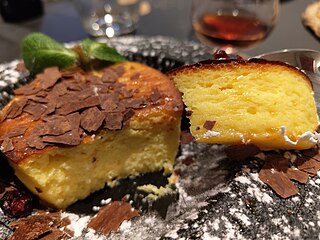
Fiadone is a Corsican cheesecake without a bottom layer, made of brocciu, sugar, lemon zest and eggs. The fiadone can have a round or rectangular shape. It is baked in an oven and served cold.

Cacavellu is a Corsican cake generally shaped as a crown, made of yeast dough. It is a typical dessert of the village of Vico.
Strenna is a Corsican pie having generally a round shape. The pie is typical of the cuisine of Corsica and originates from the city of Vico in Corse-du-Sud. Strenna is prepared for New Year's Day, and given as present by villagers to relatives coming to offer new year's wishes.

Brousse is a white and lumpy whey cheese from Provence, Corsica and north-western Italy. It is mostly made of whey from cow, sheep or goat milk.
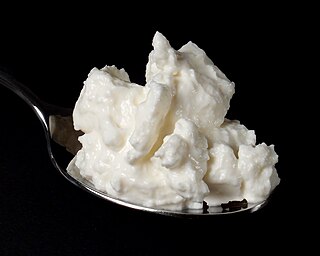
Quark or quarg is a type of fresh dairy product made from milk. The milk is soured, usually by adding lactic acid bacteria cultures, and strained once the desired curdling is achieved. It can be classified as fresh acid-set cheese. Traditional quark can be made without rennet, but in modern dairies small quantities of rennet are typically added. It is soft, white and unaged, and usually has no salt added.

Neccio, also called niccio, ciaccio or cian, is a galette based on chestnut flour, typical of some mountain zones of Tuscany and Emilia, in Italy, and of the island of Corsica, in France.
